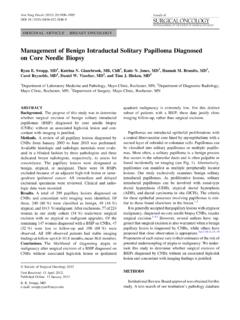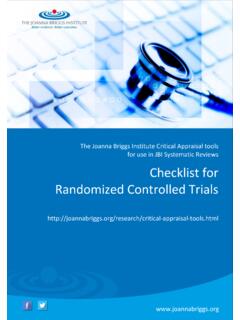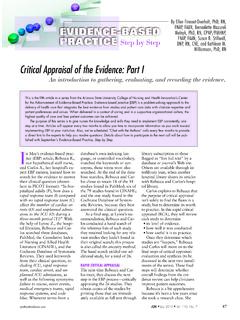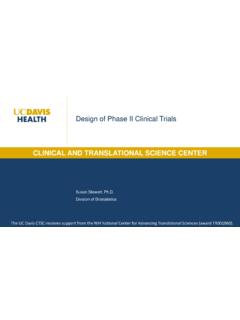Transcription of Critical appraisal handout - Rutgers Cancer Institute of ...
1 Friends of the Children of Great Ormond Street Library E-mail: Last updated January 2016 1 Critical appraisal of a journal article 1. Introduction to Critical appraisal Critical appraisal is the process of carefully and systematically examining research to judge its trustworthiness, and its value and relevance in a particular context. (Burls 2009) Critical appraisal is an important element of evidence-based medicine. The five steps of evidence-based medicine are: 1. asking answerable questions, formulating questions into a format whereby you can interrogate the medical literature and hopefully find an answer - to do this, you may use the PICO tool, which helps to break down the query into Population, Intervention, Comparison, Outcome; 2.
2 You then need to search for the evidence - if you can find a pre-appraised resource, you can miss out the next step; 3. the next step is Critical appraisal of your results; 4. you then decide what action to take from your findings; 5. finally, you evaluate your new or amended practice. UCL Library ServicesPICO tool:PopulationInterventionComparisonOut comeCritical appraisal Critical appraisal is essential to: combat information overload; identify papers that are clinically relevant; Continuing Professional Development (CPD) - Critical appraisal is a requirement for the evidence based medicine component of many membership exams.
3 Friends of the Children of Great Ormond Street Library E-mail: Last updated January 2016 2 2. Location and selection of studies Bad science We often come across news articles making unjustified scientific/medical claims. For example, in June 2008 the Sunday Express published an article about the link between suicides and phone masts: The spate of deaths among young people in Britain s suicide capital could be linked to radio waves from dozens of mobile phone transmitter masts near the victims homes. Dr Roger Coghill, who sits on a Government advisory committee on mobile radiation, has discovered that all 22 youngsters who have killed themselves in Bridgend, South Wales, over the past 18 months lived far closer than average to a mast.
4 (Johnston 2008) Ben Goldacre, a medical doctor and author of the weekly Bad Science column in the Guardian, investigated the claim made by the Sunday Express article and found out the following: I contacted Dr Coghill, since his work is now a matter of great public concern, and it is vital his evidence can be properly assessed. He was unable to give me the data. No paper has been published. He himself would not describe the work as a study . There are no statistics presented on it, and I cannot see the raw figures. In fact Dr Coghill tells me he has lost the figures. Despite its potentially massive public health importance, Dr Coghill is sadly unable to make his material assessable.
5 (Goldacre 2008) Behind the headlines The article about the link between suicides and phone masts is an example of the way in which bad science can make it to the headlines. Sometimes, however, science/health stories found in the news are genuinely based on valid studies, but jump to wrong conclusions by failing to consider some important aspects, such as the study design and the level of evidence of the original research. For instance, in July 2008 an article was published on the Daily Mail claiming that there is a link between vegetarian diet and infertility (Daily Mail Reporter 2008). The article was based on a cross-sectional study on soy food intake and semen quality published in the medical journal Human Reproduction (Chavarro et al.)
6 2008). Behind the Headlines, a NHS service providing an unbiased daily analysis of the science behind the health stories that make the news, issued the following comment: The Daily Mail today reports on, Why a vegetarian diet may leave a man less fertile. It said research has found that eating tofu can significantly lower your sperm count. The study behind this news had some limitations: it was small, and mainly looked at overweight or obese men who had presented to a fertility clinic. It focused only on soy (soya) intake, and the Daily Mail s claim that there is a causal link between eating a vegetarian diet and reduced fertility is misleading.
7 (NHS Knowledge Service 2008) Bias in the location and selection of studies Perhaps it is not surprising that the study on soy and infertility received some publicity - but if the study had not obtained positive results, would it have been published - and quoted in the news? When reviewing the literature published in scientific/medical journals, we should consider that papers with significant positive results are more likely to be: Friends of the Children of Great Ormond Street Library E-mail: Last updated January 2016 3 submitted and accepted for publication (publication bias); published in a major journal written in English (Tower of Babel bias); published in a journal indexed in a literature database, especially in less developed countries (database bias); cited by other authors (citation bias).
8 Published repeatedly (multiple publication bias); .. and quoted by newspapers! (Egger & Smith 1998; Gregoire, Derderian, & Le Lorier 1995) 3. Study design The following lists summarise the most common types of study design found in the medical literature. Qualitative studies Qualitative studies explore and understand people's beliefs, experiences, attitudes, behaviour and interactions. They generate non-numerical data. Examples of qualitative studies: Document - study of documentary accounts of events, such as meetings; Passive observation - systematic watching of behaviour and talk in natural occurring settings; Participant observation - observation in which the researcher also occupies a role or part in the setting, in addition to observing; In depth interview - face to face conversation with the purpose of exploring issues or topics in detail.
9 Does not use preset questions, but is shaped by a defined set of topics; Focus group - method of group interview which explicitly includes and uses the group interaction to generate data. (Greenhalgh 2001) Quantitative studies Quantitative studies generate numerical data or data that can be converted into numbers. Examples of quantitative studies: Case report - report on a single patient; Case series - report on a series of patients (no control group); Case control study - identifies patients with a particular outcome (cases) and control patients without the outcome. Looks back and explores exposures and possible links to outcome.
10 Very useful in causation research; Cohort study - identifies two groups (cohorts) of patients one which received the exposure of interest, and one which did not. Follows these cohorts forward for the outcome of interest. Very useful in causation as well as prognosis research. (Bandolier 2004) Key quantitative studies: Randomized controlled Trial (RCT) - a clinical trial in which participants are randomly allocated to a test treatment and a control; involves concurrent enrolment and follow-up of both groups; gold standard in testing the efficacy of an intervention (therapy/prevention); Systematic review - identifies and critically appraises all research on a specific topic, and combines valid studies; increasingly important in evidence based medicine.






